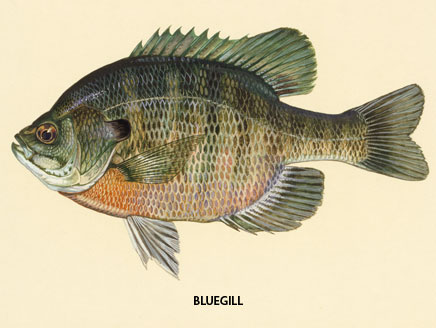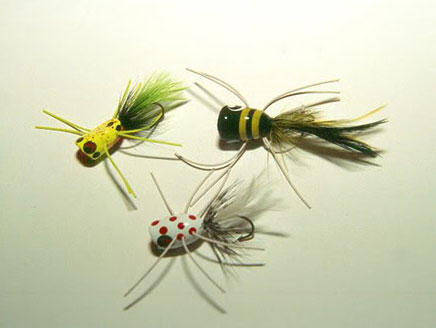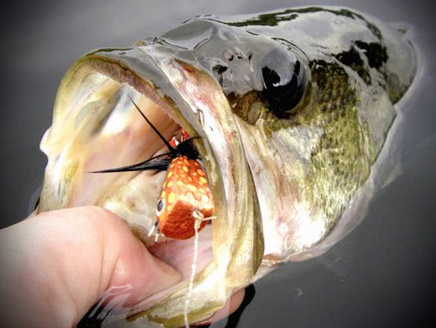

Abandon the old garden worm and float for Bluegills. That's right...grab your fly rod!
by Tom Vassallo
Most New Jersey anglers have spent time at the local pond tossing a worm or small minnow for some crappie and bass only to have a school of pesky bluegill move in and start grabbing that bait instead. Bluegills are notorious bait stealers who can drive the average angler over the edge when it seems they just can't avoid the little buggers. However, when many anglers picked up their first fishing pole, it was probably a trip with Dad or Grandpa to the pond to begin honing their casting and hooking skills. Nine times out of ten, the fish they were after were small sunfish and bluegills.
Sunfish, bluegills and small bass are all considered "panfish". The name comes from...you guessed it...how their nice small bodies or fillets fit in a frying pan! Now most members of the sunfish family can be found in nearly every stream, river, lake, or pond. In New Jersey, the most abundant species are the pumpkinseed, bluegill and red-breasted sunfish. They are best differentiated by the color and the differences in their gill flaps. The bluegill exhibits a black, rounded gill flap, the pumpkinseed has a black gill flap with a bright red-orange tip and the redbreast has an elongated gill flap with a black spot at its tip. Bluegills and sunfish eat just about any little animal that will fit into their small mouths, including aquatic insects and land insects that fall in the water. They will also eat crickets and garden worms, especially after a heavy rain.
 |
| To identify the Redbreast Sunfish, look for an elongated gill flap with a black spot at its tip. |
Members of the sunfish family are a scrappy bunch. If you have hooked into a good size bluegill on an ultra light pole, you probably enjoyed the tussle that some of these larger guys can give. But as we get older, we seem to move onto the "trophy" fish like largemouth and smallmouth bass, trout and larger members of the pike family. Those innocent days of tiny poles and tiny fish are quickly forgotten. Well, when the summer sun has driven the bass under the pads and into deeper parts away from the shore, you can breathe some new life into your freshwater fishing by abandoning the worm and float. That's right...leave those tried and true night crawlers and garden worms at home and grab your fly rod!
 |
| One of the most colorful freshwater fish is the "pumpkinseed" sunfish. A sure way to identify one is to look for a black gill flap with a bright red-orange tip. |
One of the issues with flyrodding on those lakes and small ponds is that they are inevitably surrounded by trees and branches that make a full cast virtually impossible. Well, you needn't go crazy with long casts, but if you really feel the need to do your "trout stream" cast...load up the john boat and cast towards shore. If you do approach the pond from land, I've usually found that you can find plenty of panfish close to shore, where you can pretty much just "flip" into the spaces between the pads and you should still be able to find lots of action.
 |
| The bluegill will normally display faint black bands on the side with a short black, rounded gill flap. |
If you aren't sure where they may be located where you go fishing, look for old tree stumps and other underwater structures. Sunfish are comfortable in either deep or very shallow water. In fact, they usually move back and forth, depending on the time of day or season. They also like to find shelter among lily pads and other water plants...and most of your top spots are right under those trees along the bank or the pockets between those pads.
I have found that nearly any color popper fly will work, along with any hair fly or small mosquito. However, it seems the smaller the fly...the smaller the sunfish. Remember, those really small sunfish make GREAT largemouth baits. So keep that in mind before you toss them back and try to keep a bucket close by to use them later in the day when the bass come out of the deeper water and move into the shallows to feed! Just flip a small popper into the pockets close to shore or cast from your boat, canoe or kayak right under those overhanging branches. (Be prepared to head over to those same branches and get your popper unhooked out of them too!)
 |
| Nearly any color popper fly will work, along with any hair fly or small mosquito. |
I have caught the largest sunfish and bluegills using my fly rod, but one of the best and most exciting parts of this type of fishing is when a hungry bass comes up and grabs your popper! Small largemouths will compete with the larger sunfish when foraging in the shallows. Since bluegills have been known to grow as large as 12 inches and over 4 pounds, that makes this type of fishing great fun, since you won't know what is going to grab that little bugger and pull it under the surface. It may not be the same thrill as having a big striper suck in one of your large wooden plugs...but it sure is the same type of action...on a smaller scale! Now get out there and fish!
 |
| One of the most exciting parts of this type of fishing is when a hungry bass comes up and grabs your popper! |














